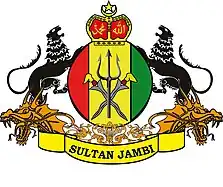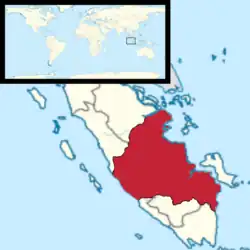Sultanate of Jambi | |||||||||||||||||||
|---|---|---|---|---|---|---|---|---|---|---|---|---|---|---|---|---|---|---|---|
| 1460 and 1615–1904 | |||||||||||||||||||
 Flag
 Coat of arms
| |||||||||||||||||||
 | |||||||||||||||||||
| Status |
| ||||||||||||||||||
| Capital | Tanah Pilih | ||||||||||||||||||
| Common languages | Malay | ||||||||||||||||||
| Religion | Sunni Islam | ||||||||||||||||||
| Demonym(s) | Jambi Malay | ||||||||||||||||||
| Government | Monarchy | ||||||||||||||||||
| Sultans | |||||||||||||||||||
• 1615–1643 | Sultan Abdul Kahar (first) | ||||||||||||||||||
• 1900–1904 | Sultan Thaha Syaifuddin (last) | ||||||||||||||||||
| History | |||||||||||||||||||
• Established | 1460 and 1615 | ||||||||||||||||||
• Disestablished | 1904 | ||||||||||||||||||
| Currency | Tin Coins | ||||||||||||||||||
| |||||||||||||||||||
| Today part of | |||||||||||||||||||
The Sultanate of Jambi (كسلطانن جمبي) also referred and spelled as Djambi in illustrations of Jambi, it was a sultanate that was centered in the modern-day province of Jambi in Indonesia.The Dutch conquered the sultanate and killed it's last ruling sultan in 1904. Jambi was first established as a Kingdom by Datuk Puduko Berhalo and later re-established as a Sultanate by Sultan Abdul Kahar of Kedah.
History
In the 600s, There was an early reference to a Malay Kingdom based in Jambi, which was eventually absorbed into the Srivijaya empire[1] as an autonomous trading community or a subject region.[2] An account associated the early history of the sultanate with the Islamization of Sumatra, citing that these two events roughly coincided in the fifteenth century.[2] The sultanate's access to natural resources as well as its strategic location, particularly its proximity to the Strait of Malacca, allowed it to flourish and be involved in international trade. By 1682, Jambi was disputed as a vassal state between the Dutch East India Company (VOC) and the Kingdom of Siam.[3]
The Jambi Sultanate was involved in the Brunei Civil War by selling Gunpowder to Muhyiddin,[4] who was in the Brunei Civil War and would later defeat Abdul Hakkul Mubin in Palau Cermin.
In the late 19th century the sultanate was slowly annexed by the Dutch, with the sultan degraded to a puppet ruler. This culminated in 1883 with the invasion of the Dutch-controlled Palembang by Jambi's Sultan, Mohammad Fakhruddin, which gave the Dutch the pretext to finally gain control of Jambi, forcing the sultan to accede to their authority and provide significant economic concessions.[5] By 1907 the last vestiges of indigenous rule had been abolished.
| History of Indonesia |
|---|
 |
| Timeline |
|
|
Society
As a society, Jambi has a history of being an entrepot and a trading center that is open to outsiders.[6] This is demonstrated in the way Jambi families easily incorporate outsiders, particularly men as well as foreigners (e.g. Chinese and Arab traders) through marriage into the Jambi womenfolk.[6] For instance, a Jambi pengiran (prince) adopted a Dutch official as his son, resulting to kinship obligations between the Dutch and the royal family.[6]
Gallery
 Letter from the Sultan of Jambi containing his credentials
Letter from the Sultan of Jambi containing his credentials Engraving of the sultan's residence (1893)
Engraving of the sultan's residence (1893) Surrender of the Crown Prince of the Sultanate of "MartaNingrat", Djambi (Jambi), in Sumatra before the Dutch residency official O.L. Helfrich, who takes the insignia in reception (March 26, 1904)
Surrender of the Crown Prince of the Sultanate of "MartaNingrat", Djambi (Jambi), in Sumatra before the Dutch residency official O.L. Helfrich, who takes the insignia in reception (March 26, 1904) Photograph of the Sultan Achmad Nazaruddin (1858-81) taken during a Royal Netherlands Geographical Society expedition from 1877 - 1879, by Daniël David Veth.
Photograph of the Sultan Achmad Nazaruddin (1858-81) taken during a Royal Netherlands Geographical Society expedition from 1877 - 1879, by Daniël David Veth.
References
- ↑ Arabic: Zābaj, the pronunciation of the Hokkien dialect is close to the characters 三佛齊 used in the Chinese sources for the country. See G. Schlegel: Catatan Geografis, XVI: Negara-Negara Lama…; T'oung Pao (Ser. ke-2), 2 (1901), pp. 107–138
- 1 2 Locher-Scholten, Elsbeth (2018). Sumatran Sultanate and Colonial State: Jambi and the Rise of Dutch Imperialism, 1830–1907. Cornell University Press. p. 38. ISBN 978-1-5017-1938-7.
- ↑ Gentle Janus, Merchant Prince at Google Books
- ↑ Asrul, Nurul Nadhirah Ahmad (2017-12-11). "Warkah Kesultanan Brunei yang tertua". Warkah Kesultanan Brunei yang tertua. Retrieved 2023-04-07.
- ↑ Brown, Iem (2009). The Territories of Indonesia. London: Routledge. p. 268. ISBN 978-1-85743-215-2.
- 1 2 3 Janowski, Monica; Kerlogue, Fiona (2007). Kinship and Food in South East Asia. Copenhagen: NIAS Press. p. 68. ISBN 978-87-91114-93-9.